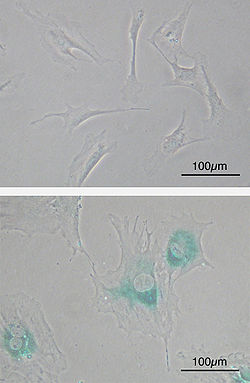Cellular senescence[edit]
Cellular senescence is the phenomenon by which normal diploid cells cease to divide. In cell culture, fibroblasts can reach a maximum of 50 cell divisions before becoming senescent. This phenomenon is known as "replicative senescence", or the Hayflick limit in honour of Dr. Leonard Hayflick, co-author with Paul Moorhead, of the first paper describing it in 1961.[6] Replicative senescence is the result oftelomere shortening that ultimately triggers a DNA damage response. Cells can also be induced to senesce via DNA damage in response to elevated reactive oxygen species (ROS), activation of oncogenes and cell-cell fusion, independent of telomere length. As such, cellular senescence represents a change in "cell state" rather than a cell becoming "aged" as the name confusingly suggests. Although senescent cells can no longer replicate, they remain metabolically active and commonly adopt an immunogenic phenotypeconsisting of a pro-inflammatory secretome, the up-regulation of immune ligands, a pro-survival response, promiscuous gene expression (pGE) and stain positive for senescence-associated β-galactosidase activity.[7] The nucleus of senescent cells is characterized by senescence-associated heterochromatin foci (SAHF) and DNA segments with chromatin alterations reinforcing senescence (DNA-SCARS).[8] Senescent cells are known to play important physiological functions in tumour suppression, wound healing and possibly embryonic/placental development and paradoxically play a pathological role in age-related diseases.[9] The elimination of senescent cells using a transgenic mouse model led to greater resistance against aging-associated diseases,[10]suggesting that cellular senescence is a major driving force of ageing and its associated diseases.

No comments:
Post a Comment